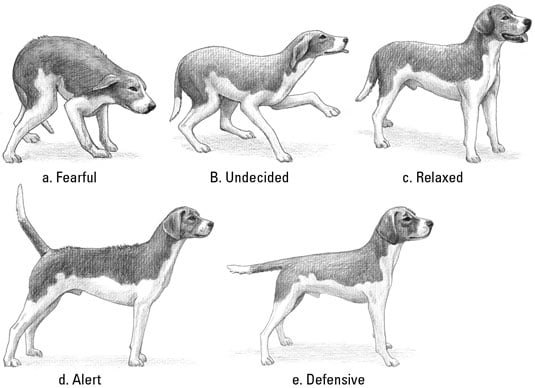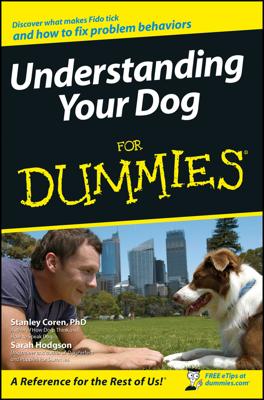Body language is an integral part of Doglish — your puppy's first language. Play, tension, relaxation — they all have different postures. Your puppy thinks you’re a dog, and she doesn’t grasp the “I’m pushing you frantically because I’m unhappy with your greeting manners” concept.
By dealing with a situation this way, you’re communicating differently than you think you are. By pushing and shouting, you’re actually copying her body language, which reinforces her behavior.
Puppies talk with their bodies, so you need to learn to listen with your eyes, not your ears. More specifically, you can translate your puppy’s “talk” by watching her tail and body postures, mouth, ear angulations, and eyes. Use the following figure and table to interpret what she’s saying.

| Body Part | Fearful | Undecided | Relaxed | Alert | Defensive |
|---|---|---|---|---|---|
| Eyes | Squinting, darting, unfocused | Focused or shifting | Focused or dozing | Attentive, focused | Glaring, hard |
| Body | Low, arched, pulled back and down, hackles may be up | Shifting from forward to pulled back, approaching but then immediately avoiding the person | Relaxed | Comfortable posture, leaning toward an interest, moving side to side, or jumping if excited | Pitched forward, rigid, tense |
| Tail | Tucked under belly, wagging low | Tucked low under belly, arched slightly over back, or fluctuating between the two | Tail down in resting position | Still or gently swinging in a relaxed or slightly elevated position | Still above rump or arched above back in a tight repetitive wag |
| Mouth | Pulled back, often in a tense, nervous semi-smile | Tense, trembling, nervous licking | Relaxed | Panting, normal, may be parted in a vocalization | Tight, unflinching, may be parted in a growl or vocalization |
As you blaze the training trail, remember these guidelines for your own body language:
Stand upright and relaxed when directing your puppy. You could call this stance the peacock position. (Imagine a peacock — beautiful and proud, chest out, confident, and in control.) When giving your puppy direction or a command, throw your shoulders back and stand tall. Tell your family and friends about this position and start strutting your stuff.
If you bend over when giving your puppy a command, don’t be surprised if she doesn’t listen. You’re doing the doggy equivalent of a play bow, which is a posture that invites a game.
Don’t face off or chase your puppy when you’re mad. She’ll only think you’re playing.
When you’re trying to quiet or direct your puppy, stay calm and relaxed. Reactive posturing excites or unnerves a puppy.
Always remember that you set the example. If you’re standing upright, calm, and confident, your puppy will be more inclined to look to you for direction and reassurance.
Can you ever get down and play or cuddle with your puppy? Of course you can. When your puppy is calm or distracted with a toy or bone, you can get down on her level and talk calmly as you pet her soothingly. Avoid overexcited praise or getting down when she’s in a mischievous mood, or you’re asking for trouble!

